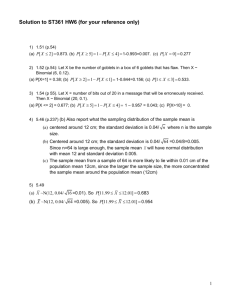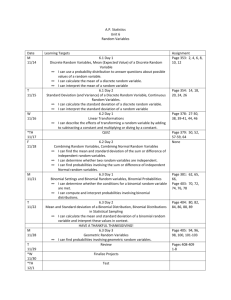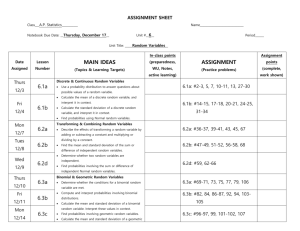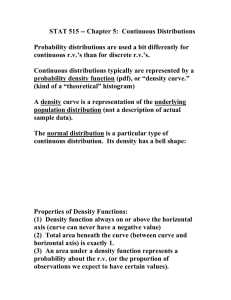chapter 7 & 8 - continuous probability distributions
advertisement
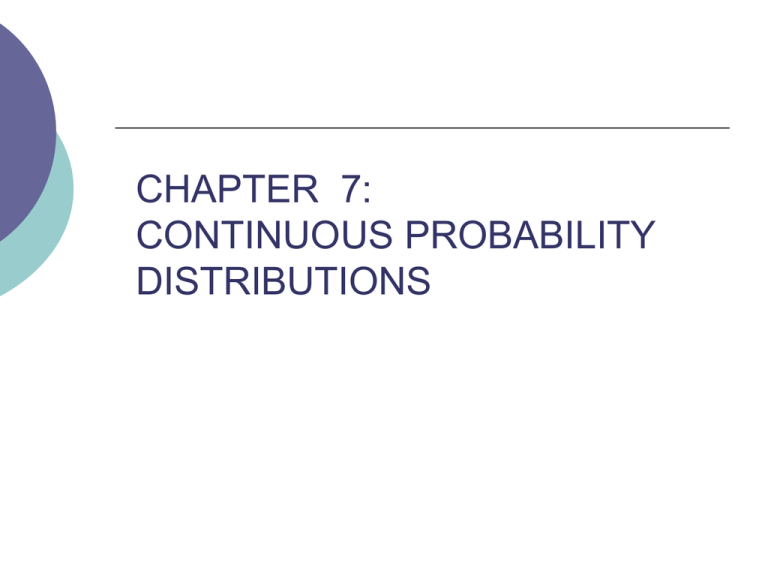
CHAPTER 7: CONTINUOUS PROBABILITY DISTRIBUTIONS CONTINUOUS PROBABILITY DISTRIBUTIONS (7.1) If every number between 0 and 1 has the same chance to be picked then the graph of the distribution looks like a rectangle. What is the probability of picking 0.75? Can not find probability of exact values. Need to find probability between values: X<value or x>value or value-1<x<value-2 To do this we use Probability Density Functions and the areas under the graph. UNIFORM DISTRIBUTION Draw Uniform Distribution on the Interval from 0 to 5 noted as [0, 5]. The probability of finding a number (any) between 0 and 5 is 1.0. Let the area under the graph be this probability P(0≤x ≤5) = 1.0 If the height of the rectangle is the Probability Density = 1/(length of the interval) = 1/5 = 0.2 UNIFORM DISTRIBUTION Find the height of the rectangle = p(x). The area of the rectangle is 1 and the base is the length of the interval [A, B] so 1 p( x) B A UNIFORM DISTRIBUTION Now we can use the area under the graph between any two points in the interval such as [a, b] to find the probability of finding the probability of selecting a number in that interval. 1 P(a x b) (b a ) * p( x) (b a) B A P (2 x 4) In the interval[0, 5] the is the area under the graph between 2 and 4, 1 (4 2) 2(0.20) 0.40 50 CONTINUOUS PROBABILITY DISTRIBUTIONS IN A CONTINUOUS DISTRIBUTION: THE AREA UNDER THE CURVE IS THE % OF THE POPULATION BETWEEN X-LOW AND X-HIGH; AND THE AREA UNDER THE CURVE BETWEEN X-LOW AND X-HIGH IS THE PROBABILITY OF SELECTING A NUMBER BETWEEN THE X-LOW AND X-HIGH. CONTINUOUS PROBABILITY DISTRIBUTIONS AREA = PROBABILITY = % OF POPULATION AREA = PROBABILITY = % OF POPULATION AREA = PROBABILITY = % OF POPULATION AREA = PROBABILITY = % OF POPULATION NORMAL PROBABILITY DISTRIBUTION (7.1) Normal Probability Equation: 1 p( x) e 2 ( x ) 2 2 Revisit Empirical Rule: AREA=% OF POPULATION=PROBABILILTY NORMAL PROBABILITY DISTRIBUTION PROPERTIES The area under the bell shaped curve is symmetric about the mean. The x-axis is a horizontal asymptote, so the curve goes from - ∞ and ∞. There are inflection points on each side of the mean are at +/- 1σ. NORMAL PROBABILITY DISTRIBUTION PROPERTIES Draw a Normal Curve for a distribution with a mean of 20 and a standard deviation of 4. Show the 1 , 2 , 3 values. Do the same for mean of 15 and standard deviation of 3 and shade areas between 6 and 9 or greater than 21. STANDARD NORMAL PROBABILITY DISTRIBUTION Standard Normal Distribution is a Normal Distribution with mean = 0 and std. dev. = 1. The x-axis becomes the Z-axis Find z-score for any value x in a Standard Normal Distribution. STANDARD NORMAL PROBABILITY DISTRIBUTION Find the probability in an area under the curve between Z values. Area in the tails of the curve will be called the p-value in future chapters and significance ( ) Find Probabilities Using Tables Find Probabilities Using Calculator. Calculator: 2nd DIST 2. Normalcdf(Z-low, Z-high) STANDARD NORMAL PROBABILITY DISTRIBUTION DRAW THE GRAPH WITH SHADING DRAW THE GRAPH WITH SHADING DRAW THE GRAPH WITH SHADING STANDARD NORMAL PROBABILITY DISTRIBUTION Inverse Normal: Given an area (probability) find the corresponding Z value Calculator: 3. InvNorm(area to LEFT). Will use this to find the CRITICAL VALUE in future chapters ( Z like Z 0.20 ) What if you are given the area to the right of the Z you want to find. Example of an entire distribution. NORMAL PROBABILITY DISTRIBUTION (7.2) Finding probability (area) if mean not 0 and std. Dev. not 1. Could do like Empirical Rule only finding Z’s that are not whole numbers. Or Use Calculator: 2nd Distr 2. Normalcdf(x-low, x-high, mean, std. dev.) Examples and applications. NORMAL PROBABILITY DISTRIBUTION Examples of eggs with mean of 61 gr. and a standard deviation of 2.4 gr. Gestation periods of 108 days with a standard deviation of 8 days. Weights of packages of food or drinks. SAMPLE MEAN PROBABILITY DISTRIBUTIONS (8.1) Given a normal distribution of a random continuous variable. Take a sample of 10 from the distribution and find the mean of the sample x . Do it again and again, maybe 10,000 times. Plot the frequency graph of the 10,000 means. What does this distribution look like? SAMPLE MEAN PROBABILITY DISTRIBUTIONS Will the distribution of the sample means be normal? What will be the mean of the Sample Mean distribution? Will this distribution be the same width, wider or narrower than the original normal distribution(in other words will the Standard Deviation be different)? SAMPLE MEAN PROBABILITY DISTRIBUTIONS The mean of the sample mean distribution will be the same as the parent distribution: x x The standard Deviation of the sample mean distribution will be the parent standard distribution divided by the square root of the sample size: x nx SAMPLE MEAN PROBABILITY DISTRIBUTIONS Given the mean and standard deviation of a normal distribution, find the mean and standard deviations of sample mean distributions of various sizes. Given the mean and standard deviation of a normal distribution find P( x) for various scenarios. SAMPLE MEAN PROBABILITY DISTRIBUTIONS To find P(x x x ) using the calculator: L normalcdf H x xL , xH , x , n CENTRAL LIMIT THEOREM Even if the parent distribution is not normal, the Sample Mean Distribution from the parent distribution will be if the sample size is n 30 . The result is that we can use the normal distribution to find the probabilities of means, even if the parent distribution is not normal. CENTRAL LIMIT THEOREM Examples: Eggs with mean of 61 gr. and a standard deviation of 2.4 gr. n = 10 Gestation periods of 108 days with a standard deviation of 8 days. n = 40 Weights of packages of food or drinks. n = 5 NORMAL APPROXIMATION OF A BINOMIAL DISTRBUTION (8.2) How can we convert a discrete distribution to a continuous distribution? When we use the proportion in place of the count. As an example for a binomial distribution let x = 40 and n = 200, then the proportion is 0.05 (a continuous value). NORMAL APPROXIMATION OF A BINOMIAL DISTRBUTION x The proportion of a population p N that has a given attribute is approximated by a sample proportion x p n According to the Law of Large Numbers, the larger the sample size n is, the closer the approximation will be to the actual population proposal. NORMAL APPROXIMATION OF A BINOMIAL DISTRBUTION The distribution of as p. The mean of p is the same p p and the Standard deviation of p p*q n NORMAL APPROXIMATION OF A BINOMIAL DISTRBUTION It would be beneficial to use the normal distribution to find probabilities of proportions. And we can use the Normal Distribution to find probabilities of the Binomial Distribution using the proportion, but ONLY IF the distribution of the proportion looks approximately normal. NORMAL APPROXIMATION OF A BINOMIAL DISTRBUTION The proportion distribution will be approximately normal when: The sample size is big enough: n* p*q10 And if the sample size is not too big: n 0.05N NORMAL APPROXIMATION OF A BINOMIAL DISTRBUTION So if the conditions are met we can use the normal distribution tools and calculator functions to find proportion probabilities We can find P(plow p phigh ) using normalcdf plow , phigh , p, pq n NORMAL APPROXIMATION OF A BINOMIAL DISTRBUTION Alternatively we could use the mean and standard deviation of the binomial distributions (values of x) and find P( xlow x xhigh ) and using: normalcdf xlow , xhigh , n * p, n * p * q NORMAL APPROXIMATION OF A BINOMIAL DISTRBUTION Do the following both ways: Give a binomial distribution with p = 0.3 and n = 200, find P(x > 40) Show requirements are met if N =100,000 Find P(p > 0.35) and others using normal approximation of binomial



